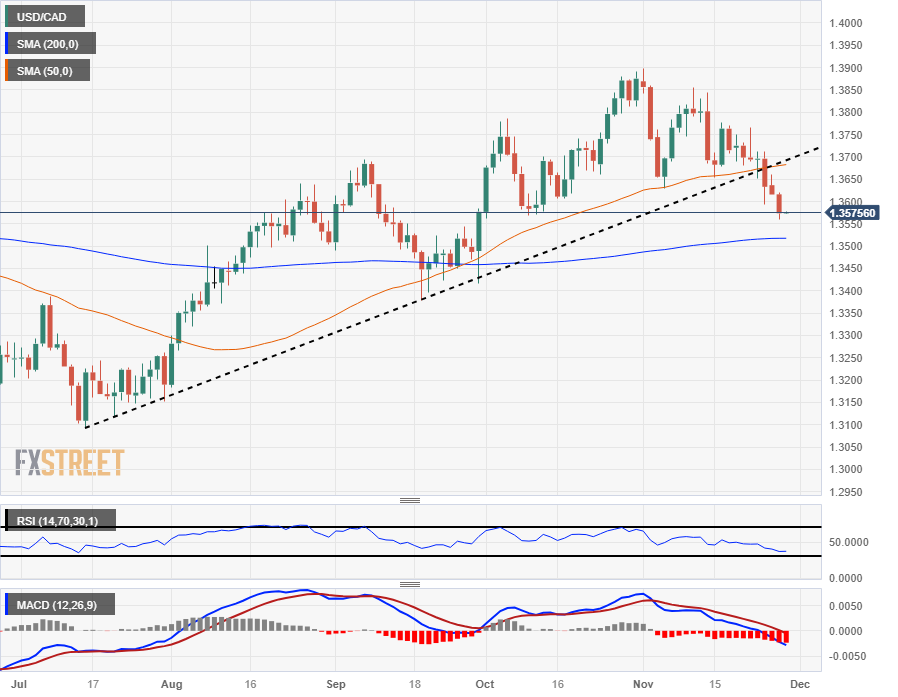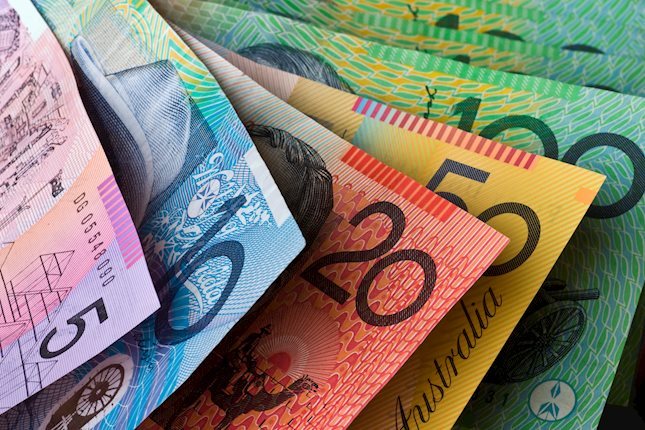- The Canadian Dollar saw some some lift on Tuesday as Crude Oil rebounds from early week swing low.
- Current Account figures from Canada and US quarterly GDP update on the docket for Wednesday.
- The US Dollar is down across the board on Tuesday, helping to bolster the Loonie.
The Canadian Dollar (CAD) clambered higher against the US Dollar (USD), driven by a general decline in the Greenback and a slight boost from Crude Oil prices recovering from Monday’s swing low.
The economic calendar is strictly mid-tier on Tuesday. Despite mixed results for US figures overall, market sentiment appears to be on the front foot with the USD receding slightly against its major currency peers.
Daily Digest Market Movers: Canadian Dollar sees bids, buoyed by broad market Greenback weakness
- The Canadian Dollar is extending against the US Dollar with mild bids on Tuesday.
- Crude Oil recovers from Tuesday’s low bids, WTI climbs 3% from $74.20 into $77.00.
- Broad markets are seeing a general softening in the Greenback, USD in the red against the entire swath of major currencies.
- Canadian third quarter Current Account slated for Wednesday, market forecasts expect a rebound in the headline figure from CAD $-6.63 billion to a surplus of CAD $1 billion.
- CAD trade balance to be overshadowed by US Gross Domestic Product (GDP) numbers in a side-by-side release schedule.
- US third quarter GDP expected to tick upward from 4.9% to 5% over the previous quarter.
- General market sentiment edging into risk appetite despite mixed US data on Tuesday.
- US Housing Price Index held steady in September at 0.6%, beating forecast decline to 0.4%.
- US CB Consumer Confidence improved in November, but October’s number sees downside revision.
Canadian Dollar price today
The table below shows the percentage change of Canadian Dollar (CAD) against listed major currencies today. Canadian Dollar was the strongest against the .
| USD | EUR | GBP | CAD | AUD | JPY | NZD | CHF | |
| USD | -0.30% | -0.49% | -0.27% | -0.53% | -0.68% | -0.53% | -0.24% | |
| EUR | 0.30% | -0.19% | 0.04% | -0.23% | -0.35% | -0.23% | 0.07% | |
| GBP | 0.49% | 0.19% | 0.24% | -0.04% | -0.17% | -0.04% | 0.26% | |
| CAD | 0.26% | -0.05% | -0.23% | -0.28% | -0.40% | -0.27% | 0.02% | |
| AUD | 0.53% | 0.22% | 0.04% | 0.27% | -0.13% | 0.01% | 0.33% | |
| JPY | 0.66% | 0.36% | 0.18% | 0.42% | 0.13% | 0.13% | 0.44% | |
| NZD | 0.53% | 0.24% | 0.04% | 0.26% | 0.00% | -0.15% | 0.31% | |
| CHF | 0.23% | -0.07% | -0.26% | -0.02% | -0.30% | -0.45% | -0.29% |
The heat map shows percentage changes of major currencies against each other. The base currency is picked from the left column, while the quote currency is picked from the top row. For example, if you pick the Euro from the left column and move along the horizontal line to the Japanese Yen, the percentage change displayed in the box will represent EUR (base)/JPY (quote).
Technical Analysis: Canadian Dollar rebound grinds the USD/CAD back into 1.3600
The Canadian Dollar (CAD) is getting a push as the US Dollar (USD) recedes against the broad FX market, taking the USD/CAD back into the 1.3600 handle on Tuesday, sliding into 1.3570.
Intraday short pressure has the pair pulling away from near-term averages, accelerating declines with the 50-hour Simple Moving Average (SMA) and 200-hour SMA struggling to keep up with declining bids.
The 50-hour SMA is providing technical resistance from 1.3620, while the 200-hour SMA sees any near-term bullish rebounds capped at 1.3690.
The pair has closed either flat or in the red for the past eight trading days, and Tuesday’s declines see the USD/CAD declining further away from the 50-day SMA near 1.3680.
Further downside will see the USD/CAD challenging the 200-day SMA currently lifting from the 1.3500 handle, while any bullish pullbacks will face resistance from the last lower swing high into the 1.3800 price level.
Technical indicators are beginning to flash warning signs that the USD/CAD is approaching oversold conditions. The Relative Strength Index is approaching the lower boundary, while the Moving Average Convergence-Divergence (MACD) sees the signal lines crossing the midpoint into oversold territory.
USD/CAD Hourly Chart

USD/CAD Daily Chart

Canadian Dollar FAQs
What key factors drive the Canadian Dollar?
The key factors driving the Canadian Dollar (CAD) are the level of interest rates set by the Bank of Canada (BoC), the price of Oil, Canada’s largest export, the health of its economy, inflation and the Trade Balance, which is the difference between the value of Canada’s exports versus its imports. Other factors include market sentiment – whether investors are taking on more risky assets (risk-on) or seeking safe-havens (risk-off) – with risk-on being CAD-positive. As its largest trading partner, the health of the US economy is also a key factor influencing the Canadian Dollar.
How do the decisions of the Bank of Canada impact the Canadian Dollar?
The Bank of Canada (BoC) has a significant influence on the Canadian Dollar by setting the level of interest rates that banks can lend to one another. This influences the level of interest rates for everyone. The main goal of the BoC is to maintain inflation at 1-3% by adjusting interest rates up or down. Relatively higher interest rates tend to be positive for the CAD. The Bank of Canada can also use quantitative easing and tightening to influence credit conditions, with the former CAD-negative and the latter CAD-positive.
How does the price of Oil impact the Canadian Dollar?
The price of Oil is a key factor impacting the value of the Canadian Dollar. Petroleum is Canada’s biggest export, so Oil price tends to have an immediate impact on the CAD value. Generally, if Oil price rises CAD also goes up, as aggregate demand for the currency increases. The opposite is the case if the price of Oil falls. Higher Oil prices also tend to result in a greater likelihood of a positive Trade Balance, which is also supportive of the CAD.
How does inflation data impact the value of the Canadian Dollar?
While inflation had always traditionally been thought of as a negative factor for a currency since it lowers the value of money, the opposite has actually been the case in modern times with the relaxation of cross-border capital controls. Higher inflation tends to lead central banks to put up interest rates which attracts more capital inflows from global investors seeking a lucrative place to keep their money. This increases demand for the local currency, which in Canada’s case is the Canadian Dollar.
How does economic data influence the value of the Canadian Dollar?
Macroeconomic data releases gauge the health of the economy and can have an impact on the Canadian Dollar. Indicators such as GDP, Manufacturing and Services PMIs, employment, and consumer sentiment surveys can all influence the direction of the CAD. A strong economy is good for the Canadian Dollar. Not only does it attract more foreign investment but it may encourage the Bank of Canada to put up interest rates, leading to a stronger currency. If economic data is weak, however, the CAD is likely to fall.
Information on these pages contains forward-looking statements that involve risks and uncertainties. Markets and instruments profiled on this page are for informational purposes only and should not in any way come across as a recommendation to buy or sell in these assets. You should do your own thorough research before making any investment decisions. FXStreet does not in any way guarantee that this information is free from mistakes, errors, or material misstatements. It also does not guarantee that this information is of a timely nature. Investing in Open Markets involves a great deal of risk, including the loss of all or a portion of your investment, as well as emotional distress. All risks, losses and costs associated with investing, including total loss of principal, are your responsibility. The views and opinions expressed in this article are those of the authors and do not necessarily reflect the official policy or position of FXStreet nor its advertisers. The author will not be held responsible for information that is found at the end of links posted on this page.
If not otherwise explicitly mentioned in the body of the article, at the time of writing, the author has no position in any stock mentioned in this article and no business relationship with any company mentioned. The author has not received compensation for writing this article, other than from FXStreet.
FXStreet and the author do not provide personalized recommendations. The author makes no representations as to the accuracy, completeness, or suitability of this information. FXStreet and the author will not be liable for any errors, omissions or any losses, injuries or damages arising from this information and its display or use. Errors and omissions excepted.
The author and FXStreet are not registered investment advisors and nothing in this article is intended to be investment advice.
Recommended content
Editors’ Picks

AUD/USD holds the uptick above 0.6450 after mixed Chinese data
AUD/USD is holding higher ground above 0.6450 in Friday's Asian trading, shrugging off mixed Chinese activity data for October. Traders are looking to cash in after the recent downfall even though the US Dollar stay firm and market mood remains cautious. US data is next in focus.

USD/JPY reverses Japan's GDP-led spike to 156.75
USD/JPY pares gains to near 156.50 in Asian session on Friday, revesing the early spike to 156.75 fuelled by unimpressive Japanese Q3 GDP data. The pair is facing headwinds from Japanese verbal intervention and a tepid risk tone, despite the sustained US Dollar strength.

Gold price extends decline on bullish US Dollar, investors brace for US PPI data
Gold price struggles to gain ground around $2,570 on Friday after bouncing off a two-month low in the previous session. The precious metal remains under selling pressure amid the strong US Dollar and the rising uncertainty surrounding the Federal Reserve's pace of interest rate reductions.

Bitcoin Price Forecast: BTC eyes $100K, what are the key factors to watch out for?
Bitcoin trades below $90K in the early Asian session on Friday as investors realized nearly $8 billion in profits in the past two days. Despite the profit-taking, Bitwise CIO Matt Hougan suggested that BTC could be ready for the $100K level, fueled by increased stablecoin supply and potential government investment.

Trump vs CPI
US CPI for October was exactly in line with expectations. The headline rate of CPI rose to 2.6% YoY from 2.4% YoY in September. The core rate remained steady at 3.3%. The detail of the report shows that the shelter index rose by 0.4% on the month, which accounted for 50% of the increase in all items on a monthly basis.

Best Forex Brokers with Low Spreads
VERIFIED Low spreads are crucial for reducing trading costs. Explore top Forex brokers offering competitive spreads and high leverage. Compare options for EUR/USD, GBP/USD, USD/JPY, and Gold.